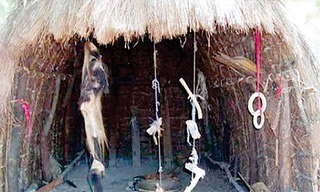In August 2004, about 50 officers of the Nigeria Police Force, including members of the Special Anti-Robbery Squad, attacked a compound containing several shrines in Umuhu Okija village, Ihiala Local Government Area of Anambra Statein the southeast of the country. In the forests where the main temples were located, police discovered human skulls and the remains of dozens of bodies, some dismembered, others in coffins and still others lying on the side of the road.
Following this discovery, police arrested several people suspected of being responsible for the Okija Shrine. Most of them were apparently members of the same extended family. Finally, the police in the capital Abuja presented 31 suspects to the press, who were arrested in connection with the discovery of 83 corpses – 63 of which were headless – and twenty skulls.
The case attracted enormous attention in the Nigerian press, particularly when it was confirmed that prominent politicians had visited the shrine and taken the oath there. Much of the press commentary was based on speculation that the shrine may have been the site of so called “ritual killings” a term often used for murders committed in the pursuit for spiritual power. One of the most famous cases – which, as we will see, had a slight connection to the Okija- Shrine- occurred in 1996 when some businessmen from Owerri in Imo State allegedly used a hotel to commit murders in order to obtain body parts for ritual purposes.

These accusations led to serious riots and the burning of about 25 buildings, including at least one church. Perhaps such incidents have led some commentators to speculate that the Okija Temple was used for similarly nefarious purposes. Another consequence was that the sanctuary could be a meeting place for a secret society. Such associations have always played an important role in Nigerian politics, although they are expressly banned in the country’s 1999 constitution. Instead of withering and dying in the face of modern nationalism, as some observers might have expected, they actually thrived in a changing political environment.
The Okija Shrine is historically part of a ritual complex dominated by Ibinukpabi, the principal oracle of Aro, for perhaps two centuries or more. According to the first British administrator, before the colonial era, “the active administration” of the region “was in the hands of those who had acquired the highest title.” It was these ambitious and rich people who had the greatest influence in the family and formed the village council.
The scattered settlements that made up Okija were incorporated into the colonial system of indirect rule after 1009, when Okija was placed under the jurisdiction of the native court. Since the beginning of colonial rule, Okija was closely linked to Ihiala, a town on the important Owerri-Onitsha Road. The colonial government placed Okija and Ihiala in the same administrative unit because they “worship the common juju.”
The head priest of this Juju is located in the oldest district of Okija, but each district also has its own temple. Ihiala itself, about 10 to 15 kilometers from the present site of the Okija Temple, was plagued by chieftaincy disputes from 1945 to 1962, reaching the point where an official commission of inquiry was set up. Detailed testimony from community members collected during the investigation revealed that the region’s regent and notables had in the past consulted the Oracle of Ibinukpabi on the appointment of a new chief. After colonial rule was established in the region, they continued to attempt to follow precedents in many respects, with the exception of what were officially termed “vile customs and practices,” meaning “things such as human sacrifice, rituals, the sale and purchase of “Were” meant “human being”.

